Key takeaways:
- Flushing involves giving cannabis plants only water before harvest to remove excess nutrients, enhancing flavor and smoothness in the final product.
- The optimal flushing period typically starts 1-2 weeks before harvest, guided by trichome color changes and gradual nutrient reduction.
- Successful flushing is indicated by lighter leaf color, improved taste and aroma, and overall plant vigor post-flush.
- Maintaining pH balance and using increased water volume during flushing are crucial for effective nutrient removal and plant health.
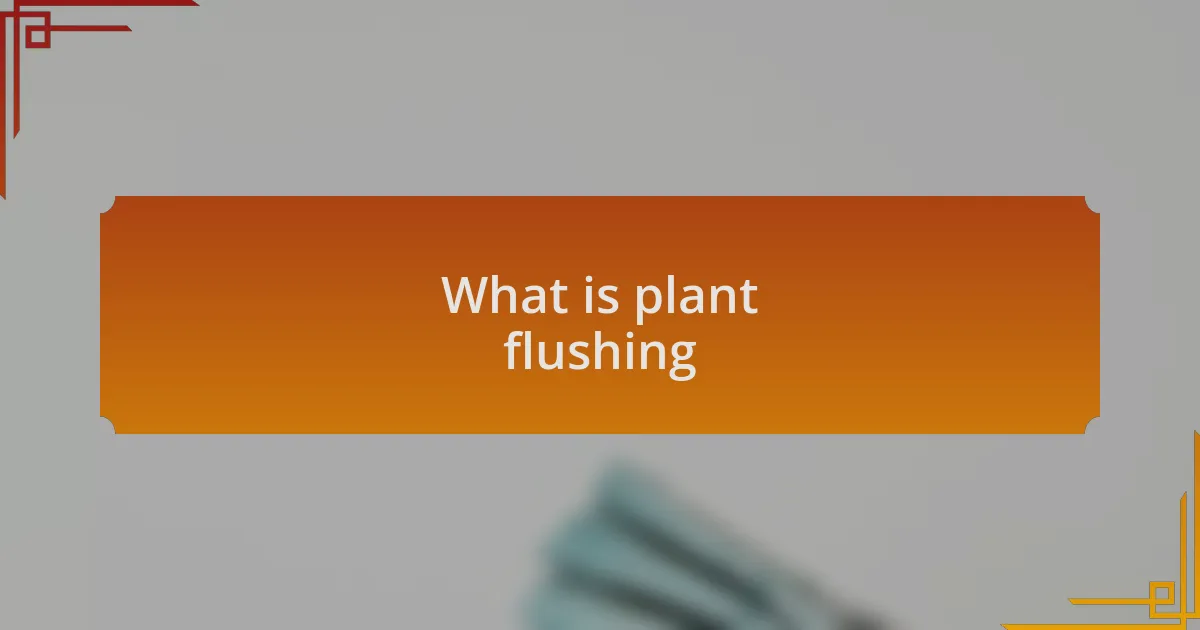
What is plant flushing
Plant flushing is the process of giving your cannabis plants only plain water in the final weeks before harvest. This practice helps to remove excess nutrients from the soil and the plant itself, allowing the natural flavors and aromas of the cannabis strain to shine through. I remember the first time I flushed my plants; I was surprised at how much smoother the smoke was, enhancing my overall experience.
During flushing, your plants may start to show signs of nutrient deficiencies, such as yellowing leaves. While this might seem alarming, it’s actually an indicator that the plants are consuming their stored nutrients. Did you ever compare a washed apple with its non-washed version? The flushed buds can have that fresh appeal, free from any chemical taste.
Flushing also serves as a way to prepare the plants for a stress-free harvest. When I observed the change in my plants, it felt like they were purifying themselves, almost like they were anticipating the big moment. Have you considered how this final preparation might enhance your end product? By refining the plants this way, many growers, including myself, have found that they enjoy the end result much more.
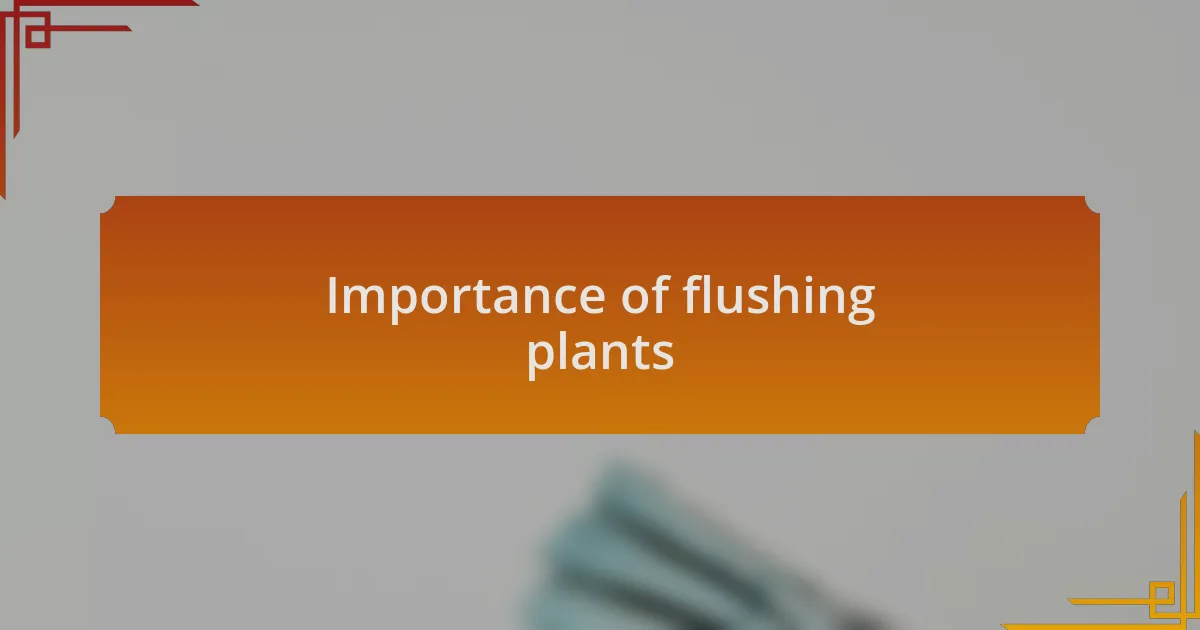
Importance of flushing plants
Flushing plants is crucial for ensuring that the final product is not only potent but also flavorful. I recall a specific grow where I decided to skip flushing, thinking it wouldn’t make much difference. The smoke was harsh, and the flavors were muted, leaving me disappointed. Have you ever tasted something that just didn’t live up to the hype? This experience cemented my understanding of how flushing can elevate the quality of the bud and enhance the overall smoking experience.
Another key aspect of flushing is how it can affect the plant’s health leading up to harvest. When I noticed my plants gradually changing, I began to feel a connection with them. They were shedding the excess and focusing on what truly matters: producing the best buds possible. It’s fascinating to think about how plants have their own way of preparing for a significant event, much like how athletes might train before a big game. How much better would our successes be if we could streamline our efforts in the same manner?
Ultimately, flushing helps to showcase the unique qualities of each strain. I remember savoring the difference between two batches, one of which had been flushed rigorously. The distinct flavors became more pronounced, leading to an enjoyable complexity that was hard to forget. Have you ever had a favorite strain that took you by surprise? That’s the potential in a well-flushed plant—it’s a chance to discover and enjoy the full spectrum of what cannabis can offer.
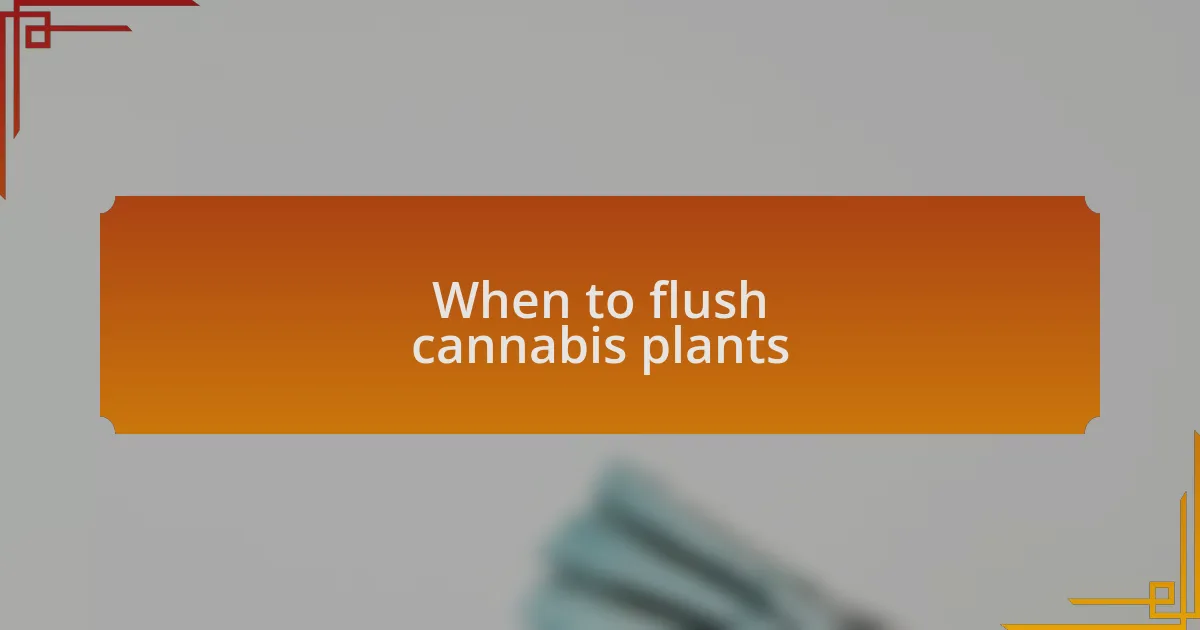
When to flush cannabis plants
When it comes to flushing cannabis plants, timing is everything. I typically start the flushing process about one to two weeks before harvest, depending on the strain and the plant’s overall health. It’s fascinating how just a little patience can significantly enhance the flavor profile, like letting a fine wine breathe. Have you ever held back for just the right moment only to be rewarded with something extraordinary?
Observing the trichomes can also guide your flushing timetable. I remember peering closely at my buds, watching as the trichomes shifted from clear to a cloudy hue. This visual cue told me that the plants were nearing their peak potency and that it was time to let go of the nutrients. Isn’t it remarkable how nature gives us these signs, much like an artist perfecting their masterpiece?
Lastly, I can’t stress enough the importance of preparing your plants before flushing. I’ve learned to gradually reduce nutrient input in the days leading up to flushing. It creates a smoother transition to just water, allowing the plants to naturally release any remaining fertilizers. It can be surprising how little adjustments, like a simple change in feeding schedule, can have such a profound impact on the end result. Have you ever tried that approach, feeling the anticipation build as the plants respond?
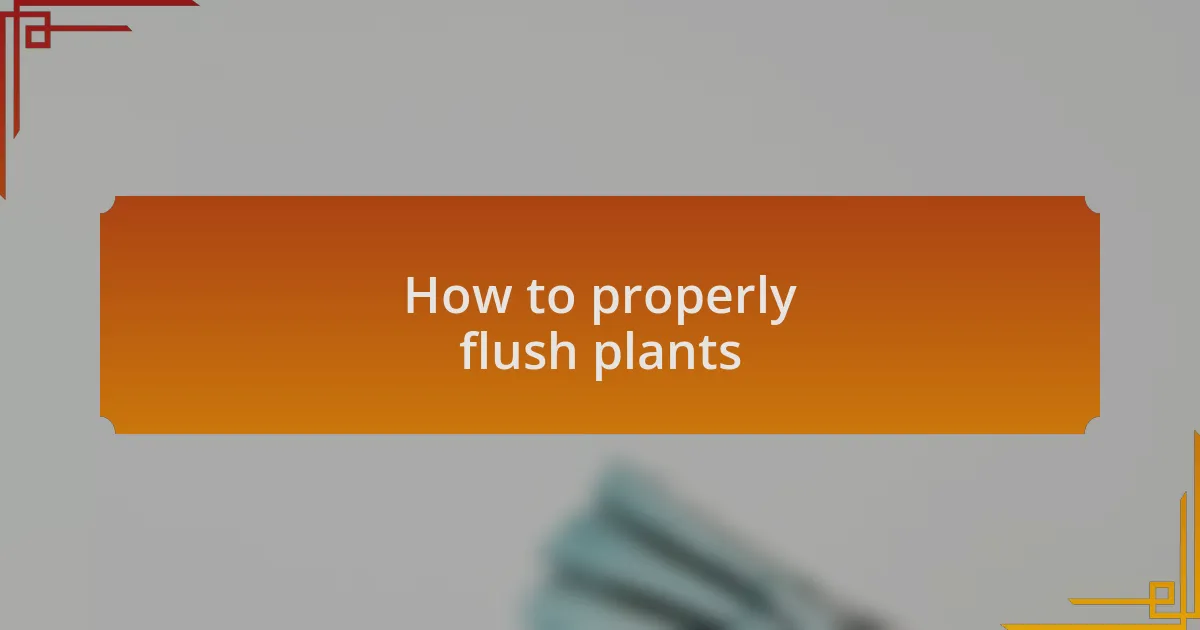
How to properly flush plants
To properly flush your cannabis plants, it’s essential to use clean, pH-balanced water. I remember the first time I neglected this step; my plants didn’t respond well at all. After that, I made it a habit to check the pH, ensuring it stays between 6.0 and 7.0, which allows the plants to absorb water effectively without any nutrient lockout. Have you ever experienced the difference that proper pH balance can make?
During the flushing period, I’ve found it beneficial to increase the amount of water I use. For instance, I typically give my plants two to three times the pot volume, allowing for a thorough wash of residual nutrients. It’s fascinating to see how the plants seem to perk up, almost as if they are relieved to be free of the lingering nutrients. Have you felt that sense of relief when your plants look more vibrant?
Finally, monitoring your plants after flushing has been crucial in my experience. I usually check them daily for signs of stress or over-watering. For example, if the leaves begin to droop, I know I need to adjust my watering technique. Reflecting on this, have you noticed how small changes can either positively or negatively impact your plants? Understanding these nuances can lead to a truly rewarding harvest.

Signs of a successful flush
When you’ve successfully flushed your cannabis plants, one of the first signs I look for is a change in leaf color. After flushing, the leaves often transition from a deep green to a lighter shade as the nutrients deplete. It’s like watching a subtle transformation unfold, signaling to me that the plants are no longer relying on those excess nutrients. Have you ever noticed that shift and felt a sense of accomplishment?
Another indicator of a successful flush is the taste and aroma during the final stages of growth. I vividly remember when I harvested a batch with a brilliant citrus scent after I got the flushing just right. Previously, when I hadn’t flushed thoroughly, there was an unpleasant chemical taste that left me dissatisfied. Isn’t it incredible how those simple steps can elevate the overall quality of your harvest?
Finally, the overall vigor of the plants after flushing speaks volumes. I’ve experienced plants that bounce back with renewed energy, showing healthy growth patterns. This revitalized appearance not only boosts my confidence but also reassures me that I’ve done my job well. When was the last time you felt that excitement seeing your plants thrive?

Personal experience with flushing plants
Flushing plants has been a game-changer in my growth routine. I remember the first time I flushed my crop before harvest; I was hesitant, wondering if I was pushing the plants too far. Watching them droop slightly initially felt disheartening, but I knew that the process would lead to a better end product—the anticipation was both exciting and nerve-wracking. Have you ever felt that tension before a big decision in your grow?
One instance that stands out was when I was nearing the end of a particularly long flowering phase. I decided to flush for a full week, and those days felt like a rollercoaster. Each day, I checked for signs of the plant’s response, and by the fourth day, I was overcome with joy as I saw the leaves becoming lighter. The transformation felt like a beautiful revelation, affirming my belief in the importance of flushing. How often do we overlook the power of such simple practices in our cultivation journeys?
On another note, the improvement in the smoke quality post-flush made me a firm believer in the process. After that successful harvest, I hosted a small gathering to share my creation, and the rich flavors left everyone impressed. I still remember the smiles as they enjoyed the citrus notes, all thanks to my commitment to flushing. Isn’t it remarkable how a little effort can lead to such rewarding experiences?
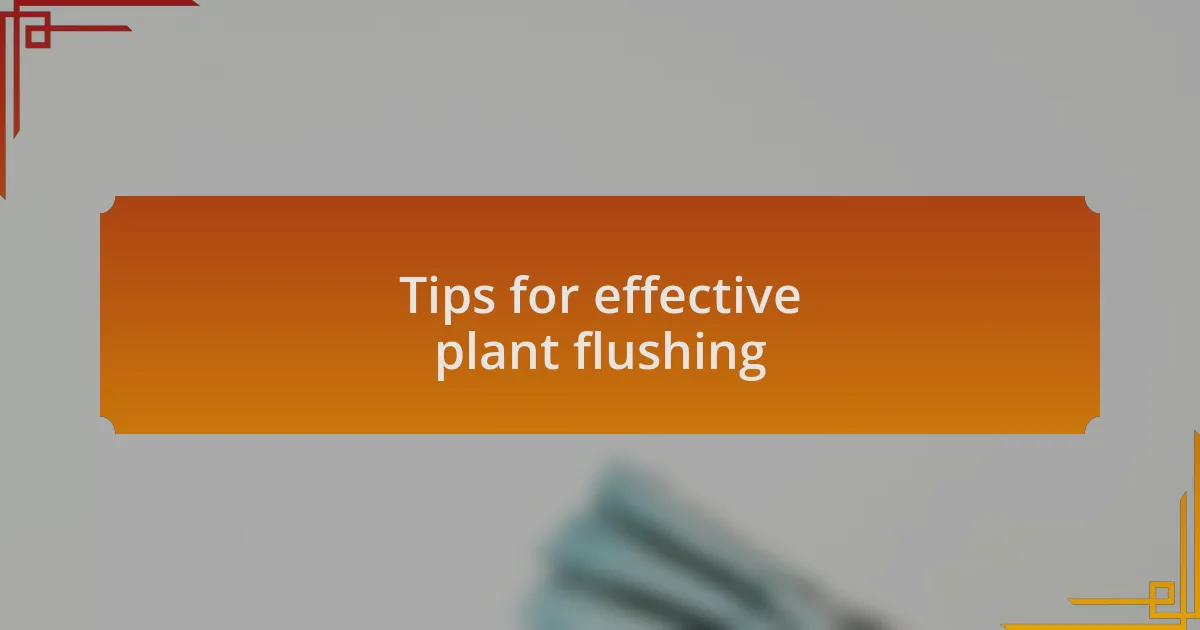
Tips for effective plant flushing
When it comes to effective plant flushing, timing is everything. I learned the hard way that flushing too early can lead to underdeveloped flavors and potency. I found that waiting until the trichomes were mostly cloudy gave the best results. Have you ever noticed how some plants respond differently? It’s a subtle dance between patience and observation.
Watering with a higher volume than usual is another tip that’s significantly improved my results. The first time I tried this, I was apprehensive but then watched as the soil turned from muddy brown to a vibrant, clean hue. It was like a cleansing ritual for my plants, and the earthy scent that permeated the air felt refreshing. Can you recall moments in your grow where you stepped out of your comfort zone and were pleasantly surprised?
Lastly, maintaining a close eye on the pH during the flush has been crucial for me. There was one harvest where I neglected this small detail, and the plants suffered. Since then, I always ensure my flushing water is slightly acidic to promote nutrient absorption. Have you considered how pH adjustments can make a notable difference in your results? It’s these small, intentional tweaks that elevate the quality of your crop, something I’ve come to deeply appreciate in my journey.